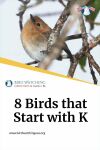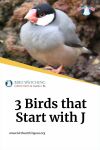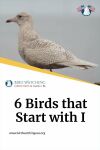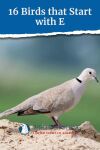
Introduction
Can you think of a bird that starts with E? Well, you’ll be surprised to know that there are only 16 really common birds in the USA and Canada that begin with the letter E. That’s not really much, is it? It’s only 2.1%, so it’s alright if you don’t already know about those birds because we are here to help you out! From gooses, sparrows, owls, and geese - there’s so much to expect!
So let’s dive into the list of the most common birds that start with E. Note that these are according to the number of the species found in the USA and Canada only. Also, I’ve arranged them in descending order so you know which bird is the most common of them all! All the information was retrieved from the lovely folks at EBirds, so a big thanks to all the bird lovers there for contributing to the database!
Here’s a sneak peak of the list.
| European Starling | 24.51% |
|---|---|
| Eastern Bluebird | 10.58% |
| Eastern Phoebe | 9.39% |
| Eastern Towhee | 7.67% |
| Eurasian-Collared Dove | 5.90% |
| Eastern Kingbird | 4.69% |
| Eastern Wood Pewee | 4.51% |
| Eastern Meadowlark | 3.06% |
| Eared Grebe | 1.15% |
| Evening Grosbeak | 0.58% |
| Eastern screech-owl | 0.50% |
| Eurasian Wigeon | 0.20% |
| Elegant Tern | 0.20% |
| Egyptian Goose | 0.18% |
| Eastern Whip-poor-will | 0.17% |
| Eurasian Tree Sparrow | 0.13% |
Now let’s go through the details below. They’re all breathtakingly beautiful but I can’t help but adore #10!
1. European Starling
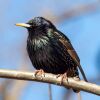
The European Starling takes the spot for number one. It’s the bird that’s found mostly in North America. They have long pointed bills, short tails, triangle-shaped wings, and a black body.
Their taste buds are very diverse, meaning they can recognise citric acid, sugars, salt, and many other elements found in fruits. Since they are so abundant, I was able to attract one to my backyard myself. Fruits make an excellent choice and you can set up a birdfeeder for it.
Another fascinating thing about these birds is that their appearance changes from one season to another. In winter, white spots will appear on their bodies. But when I saw them in the summer, they looked much darker and shinier! The purple and green in their feathers seemed so magical. How cool is that?
So what makes these birds so common today? Let’s go a bit into history. These birds were not originally found in North America until around 100 birds were set loose in the 1890s in New York’s Central Park. It was an act done by Shakespeare enthusiasts, that wanted all the birds in America that were ever mentioned by Shakespeare. Also, did you know that a European Starling in Virginia will look quite similar to that in California?
fun fact
did you know?
They are amazing at mimicry. They can copy the voices of around 20 species. So the next time you hear a Red-tailed Hawk, Eastern Wood-Pewee, Killdeer, Wood Thrush, Northern Bobwhite, Meadowlark and many more, make sure to look twice. You might catch a European Starling making its famous voice act!
2. Eastern Bluebird
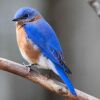
On #2 we have the Eastern Bluebird with its gorgeous blue and brown feathers!
The first time I saw this beauty was when it was foraging in the bushes and on the ground. It turned out they are quite fond of insects, but they love to eat plants as well. So if you have berries and shrubs in your backyard, you might just see this bird there. But they’re more likely to feed on plants and fruits in the winter. In the summer, they’re all about insects and even larger animals like lizards and tree frogs! If you’re lucky, you may even come across an Eastern Bluebird foraging in mid-air, all thanks to a flying insect.
As for nest building, they prefer cavities in trees. The male attracts the female through lavish displays and brings nest material into the hole. The male also partly spreads its tail and flutters in front of the female. They show affection to each other when perched together and the male even feeds the female. If you’re looking forward to attracting a pair, then you can also set up a nest box in your backyard.
If you want to go into their natural habitats, try moving towards the Eastern North America and in the South, towards Nicaragua. If you go toward the farthest north or even the farthest west, you’ll find that the birds lay more eggs. And of course, you’ll also get to listen to more of their sweet and soft melodies!
fun fact
the oldest eastern bluebird
The oldest one ever recorded was banded in South Carolina in New York in May, 1989. And he was 10 years, 6 months old and died in South Carolina in November, 1999.
3. Eastern Phoebe
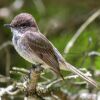
And on #3, we have the Eastern Phoebe, which is a type of flycatcher! If you see one around in the East, it’s a clear sign that Spring is near. Their call is short and they enjoy natural environments during the Spring season, hovering around in the banks of streams or even sitting or standing on rocks.
You can hear the male bird singing in the wee hours of the morning. I have even found these birds in the corners of bridges or other architectural places.So you can find them within cityscapes as well. But regardless of where they are, they take their territory seriously and defend it! And it makes sense because these birds are solitary and don’t appreciate much company. And there’s even proof for it. The female bird often chases the male away from her. Sometimes, you’ll be able to spot one male with two mates.
You can see its tail wagging too, while singing away to a soft song that sounds like repetitive ‘phoe-be’. The first syllable is either a higher or lower note than the second. Or the other way around.
fun fact
reusing the nest
The Eastern Phoebe reuses its nest. During that time, the Barn Swallows use their nests. Sometimes, the Eastern Phoebe even uses the nests of other birds too. Typically, these include the Barn Swallows and the American Robins.
4. Eastern Towhee
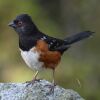
Here comes the Eastern Towhee on #4! It resembles the look of an oversized sparrow.
These omnivorous birds have quite a diverse diet for sure. In summer, you’ll find them foraging insects on the ground. It’s actually in the winter that they move more towards the plants. So if you’re like me and have some shrubs and overgrown borders in your backward, then you’re in luck! The Eastern Towhee might just leave their natural habitats of old fields and forests to pay you a visit! Oh and one more thing: They’re also attracted to bird-feeders and vegetation, so you can find them feasting on fallen seed.
They are solitary in nature. If you catch them showing off their white spots by lifting their feathers and fanning their tails, they are threatening other birds to stay away. The males also spread their tails for courting, while singing a soft song. They mew for calling and their song sounds like a repetitive ‘towhee’. You can find their nest around 5 feet above the ground, which is built by the female!
fun fact
did you know?
The Eastern Towhee and the Spotted Towhee of western North America are considered the same species. They often interbreed too while meeting in the Great Plains.
5. Eurasian-Collared Dove
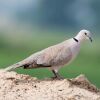
On #5 we have a symbol of peace - the elegant Eurasian-collared dove! Its tail has white patches that are distinct in the dove family, and that can make it easy for you to spot this beautiful bird.
These species can be found in both suburban and urban areas. You can even find them sitting on fences and phone wires! So if you have a birdfeeder in your backyard, it’s highly likely you spot one yourself. Want another tip? They are more likely to visit if you have millet on the ground. All in all, any sort of seed and grain will be attractive for them.
So what does it sound like? It has the same voice and calls as other doves, but quite mournful in tone. Keep your ears open for any low or depressive koo-KOO-kook - it’s coming from Eurasian-Collared Dove!
fun fact
Did you know?
The Eurasian-Collared Dove feeds its chicks with crop milk instead of insects. Now isn't that a rich protein supplement? But that's just for around 5 days, after which the chick's diet is switched to that of fruits and seeds.
6. Eastern Kingbird
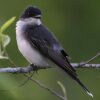
The majestic Eastern Kingbird is on #6 of this list. In the Winter, these spectacular birds are mostly found in the Amazon forest, where they enjoy foraging fruits.
But you don’t need to go there, as you can find the Eastern Kingbird in a variety of places. From fences and wires to overgrown fields in the forests and other open locations! If your backyard has a lot of trees nearby and plenty of vegetation along with tons of insects, then the Eastern Kingbird will pay a visit for sure. They love to forage both on the ground and in water but sometimes they can catch insects mid-air as well. You can see them mostly in March or April, but if you want to watch them in the South, then the best time is during July and August.
How about paying attention this bird’s sound too? Its calls are a rapid series of ‘kit and kitter’ sounds and even sharper ‘dzeet’ like sounds. Think of them like zapping or electric sparks, isn’t that amazing?
Oh and as for courting, the male flys zigzag and backwards and other aerial moves. But the nest is built by females only and you can easily find it in the most common places. You can find it typically at a height of 7 to 30 feet above the ground.
Fun Fact
Why it is called kingbird
Thanks to the crown of red, yellow, or orange feathers on its head, this bird is entitled the 'Kingbird'. Royalty indeed, isn't it?
7. Eastern Wood-Pewee
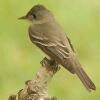
We have the Eastern Wood-Pewee at #7! Spotting this lovely brown-gray feathered bird is no joke. They can camouflage pretty well against wooden branches of the same color, can’t they? But I know exactly how you can find one.
Look out for any type of ‘knot’ in a branch. That’s what their nest looks like! But you have to look pretty high, as they build their nest around 15 to 45 feet high above the ground. Since they’re also foraging high in the trees, it’s less likely you’ll find one simply moving around on the ground. They hover very close to twigs and foliage to grab and eat insects!
The male birds often sing all throughout the day. Particularly during the early morning hours, at the time of dawn. But you can also find them singing at dusk! They may even hop from one treetop to another for courting. Their song goes like ‘pee-a-weeeee’. They are quite the entertainers, aren’t they?
fun fact
oldest eastern pe-wee
The oldest recorded Eastern Wood-Pewee was 8 years, 2 months old.
8. Eastern Meadowlark
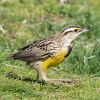
On #8 we have the sweet Eastern Meadowlark! The whistles of this bird sound like pleasant flute music. In New York alone, it was analyzed that this bird could sing up to 100 songs, as the patterns of each was different! It’s actually a member of the blackbird family and is not at all associated with the lark.
You can easily call the Eastern Meadowlark to your backyard by offering food that it loves! It walks the ground to feed on insects and seeds that it loves. They are particularly very fond of waste grain! It can even put its bill deep inside the soil to catch some bugs or seeds that are not visible. Even their nests are on the ground and you can find them in the soil, although they are not in plain sight and would be hidden in dense grass.
A male has typically two female mates. You may find both Eastern and Western Meadowlarks in the central region of the United States. However, neither of them shares the territory, nor do they mate with each other.
fun fact
Did you know?
You can spot them in flocks during the winter. As many as 200 eastern meadowlarks gather at that time to forage on seeds and grains that might be leftover after the harsh cold weather takes over!
9. Eared Grebe
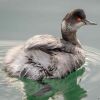
It’s the most common grebe in the world but it’s # 9 on our list! Their extraordinary bright red eyes are definitely a distinct feature.
You can witness them in thousands when they’re migrating! They head towards the North to feed on shrimps before moving towards the South. So your best bet is to find in inland waters in the same way I did! Their diet mostly consists of insects and crustaceans. But they even eat dragonflies, mayflies, tadpoles, even a couple of small fish.
And if you live in California or Utah, you can see an Eared Grebe on the Mono Lake and Great Salt Lake respectively. But this is during the Fall season from July to November. In the Spring, however, you can find many Eared Grebes at the Salton Sea from January to April.
You can even see this bird sunbathing on a cold morning, facing away from the sun! They ruffle their feathers and expose their skin to the sunlight. Oh and when they’re breeding, you can easily recognize them by their frog-like sounds! The male and the female are often seen swimming side by side during courtship, while turning their heads away from each other.
fun fact
did you know?
They shed their golden wisps during the winter season. Gray and white feathers appear in its place instead!
10. Evening Grosbeak
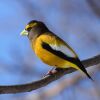
On #10 we have the beautiful yellow-and-black feathered Evening Grosbeak! Their calls are pretty simple, but I was able to identify them by their sweet yet piercing notes.
Since summer is their breeding time, you find these birds in the northern most part of North America. They’ll be waiting for you in the forests, so you can plan a nature or hiking trip! But since they’re foraging mostly high in the trees, you’ll have to move silently and be really careful when on the lookout for them. You can find the male bird dancing by raising its head and tail. Sometimes the female also participates and droops its wings and swoops in the same movement in a courtship display, accompanied with alternate bows.
They have an appetite for sunflower seeds, so fill the birdfeeder in your backyard with them! Do keep in mind though that they are irregular visitors. I witnessed an Evening Grosbeak hovering near the feeder in winter. I also put berries out there, it’s another one of their favorites, so why not? Thanks to their large bill, they can even drill through large seeds and eat them easily. If you have tree or shrub buds, you can place those too. But in the summer, they switch their diet from seeds and plant substances to insects instead. So although they forage in shrubs and trees, you’ll find them food-hunting on the ground too. It all depends on the season.
Hint: They absolutely love the buds of maple trees!
did you know?
the evening grosbeak doesn't really sing
Although the Evening Grosbeak is a song bird, it doesn't really sing. You wouldn't find it singing to defend its territory or attract a potential mate.
11. Eastern screech-owl
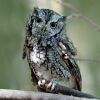
At #11, we have an owl for a winner - the Eastern screech-owl!
I had seen the Eastern screech-owl outdoors for the very first time. But I wanted to have one in my backyard too. After all, that would be a much personal and up-close experience! So I put up a nest box in hope of attracting a breeding pair. I made it look similar to the cavity of a tree, which is their natural nesting place. And guess what? I was lucky enough to host a pair, even though it did take a lot of time! The male often brought food to its female, and while courting, these birds even bow and raise their wings. Their species is highly monogamous and only a few males mate with more than one bird.
But if you don’t want a breeding pair, you can set up a birdbath too. The Eastern-screech owl forages mostly at dusk and at night. They sit on a perch and watch from the distance to spot a potential pray - either in the foliage, on the ground or even catching mid-air if they’re flying insects. Their diet is all about rodents and insects like mice, earthworms, spiders, moths, crickets, and other larger insects too. At times, they prey on smaller birds as well.
When I heard it for the first time, I was in awe of how its sounds has a series of soft trills and purrs too. Although these are more subtle notes, the most distinct sound of this bird is definitely its wailing.
did you know?
Sight and sound
The Eastern screech-owl uses both sight and sound to locate its prey!
12. Eurasian Wigeon
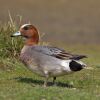
Up next on #12 is the Eurasian Wigeon!
If you happen to come across flocks of them along with American wigeons, they’re definitely migrating! I was also trying to listen to their voices, but guess what? The sound of these birds is hardly heard in America, even though I’ve been told they have pipe-like whistle calls.
They graze on the land and dabble at the water surface for foraging. They dive in their neck and heads into the water to find something to eat. Although they eat a few insects in the summer, you’ll mostly find them feasting in plants. If your backyard is full of leaves, seeds, or simply all sorts of plants, you can expect the Eurasian Wigeon to pay you a visit! They feed both during the day and night. Sometimes, they even steal food from other birds.
In courtship, you can find many males competing for a single female. They raise their heads while giving their typical whistling call. You can also expect them to unfold their wings and expose the white wing patch! They’re most likely to nest near water and on top of dense vegetation.
did you know?
the name of the eurasian wigeon
The Eurasian Wigeon falls under the species known as 'penelope'. The word has been derived from Greek mythology. It is inspired by an event in which a duck rescued Penelope, the wife of Odysseus, when she was thrown into the ocean.
13. Elegant Tern
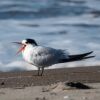
Who else could it be? It’s the Elegant Tern at #13!
You’re more likely to see one in the Fall and Spring rather in their breeding season. The California coast is a favorite spot for elegant terns to hang around. You can find them breeding in colonies. In courting, both the male and the female stretch their necks upward, droop their wings, and lower their bills.
If you listen closely, you’ll get to hear their short yet high-pitch ‘karr-eek’ calls! I couldn’t recognize them when I heard them for the very first time, until I looked up what they sound like! I also happened to come across their nest, that was a simple scrape in the soil and on open ground. They don’t shy away from building their nests openly!
If you look closely, you’ll see that they have long wings that allow them to flutter and hover above the ocean. They forage by plunging into the water to catch small fish. The northern anchovies are their most favorite!
did you know?
the oldest elegant tern
The oldest elegant tern recorded was 20 years, 11 months old in California (2010).
To make your birdwatching easier, here’s a spotting scope if you don’t already have one!
Celestron - Ultima 80 Angled Spotting Scope
This spotting scope has an 80mm objective lens and a 45 degree viewing angle, which makes it perfect for all your birdwatching needs!
14. Egyptian Goose
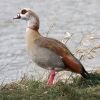
On #14 we have the Egyptian Goose! And you can tell by its name that it is actually native to Africa. But luckily for us, these birds can be found in the masses in Florida, California, and Texas. In fact, they have escaped to the extent that they have settled down in a number of locations! The lovely brown patch surrounding its eye is what I find the most attractive about this goose!
Although these birds aren’t that common as the ones we’ve gone through, they love to explore different territories. You can find them perching on buildings and trees in the states that I’ve mentioned! They love to eat plants, stems, and leaves. But occasionally, they move away from a vegetarian diet and eat small animals or insects such as worms too. So you can find them wandering near freshwater locations and on the lookout for any type of aquatic life they can feed on!
You can also use keep your ears open for their voice. The male Egyptian Goose makes noise only during courtship or when it’s aroused. It has duck-like quacks and you can also see it putting on a show to attract the female! It displays its feathers and stretches its neck while honking!
fun fact
pairing for life
The Egyptian Geese pair for life! The male and the female stay together and look after their young ones forever.
15. Eastern Whip-poor-will
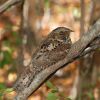
Here comes the Eastern Whip-poor-will bird at #15!
Although they are difficult to spot in their natural habitat, you can hear their distinct voice. It tends to repeat its name and more often sings in the night than the day. So summer nights are their favorite when it comes to going loud in rhythms and repeating whip-poor-will over and over again.
These birds are more active during the night, and they even forage in that time. You can find them on the food hunt in the wee hours of dawn and dusk, particularly in the moonlight. They sit in the trees or move along the woods, usually sitting on the ground first and then flying upwards.
Their diet consists entirely of insects, particularly those that fly at night. So you can expect they love mosquitoes, beetles, and moths a lot! Since they have a wide mouth, they eat up insects in whole without having to bite them into pieces.
did you know?
timing nesting activity with the moonlight
The adult birds feed the young ones at nights when the moon is half full. This is because moonlight aids them in foraging!
16. Eurasian Tree Sparrow
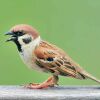
The last one on our list is the Eurasian Tree Sparrow! And it’s pretty easy to spot these sparrows. I saw one while I was walking around in the rural areas. If you try to look for these in urban locations or cityscapes, you may not have any luck. That’s because the city spots have all been overtaken by the House Sparrows!
So if you’re visiting the country side, you can find them hopping on the ground while foraging. Their diet mostly consists of seeds and insects. Try throwing some seeds around to attract their attention and you’ll find many of them flying in to thank you! They’re also attracted to waste grain, so you can also look for an area that has plenty of that.
fun fact
family of the eurasian tree sparrow
Did you know that the Eurasian Tree Sparrow isn't actually a sparrow? Yes, its sound is similar to that of the House Sparrow but both of them belong to an entirely different family, known as the Passeridae!
If you don’t have seeds to throw, here is a pack that I highly recommend. It’s big enough to last for many months!
Cole's BH10 Blazing Hot Blend Bird Seed, 10-Pound
This bird seed is a traditional mix to attract many types of birds. It's free of chemicals and other harmful substances.
Conclusion
That’s all for the most common birds that start with E in the USA and Canada. Which one made it to your list of favorites? Have you seen any of the above before? Don’t forget to follow our tips if you’re heading out for birdwatching. Oh, and if you want to learn more about the most common birds, have a look at these birds that start with the letter F !

By David A. Swanson
Bird Watching USA
My name is David and I'm the the founder of Bird Watching USA! I started Bird Watching with My father-in-law many years ago, and I've become an addict to watching these beautiful creatures. I've learnt so much over about bird watching over the years that I want to share with the world everything I know about them!

David A. Swanson
Bird Watching USA
My name is David and I'm the the founder of Bird Watching USA! I started Bird Watching with My father-in-law many years ago, and I've become an addict to watching these beautiful creatures. I've learnt so much over about bird watching over the years that I want to share with the world everything I know about them!




